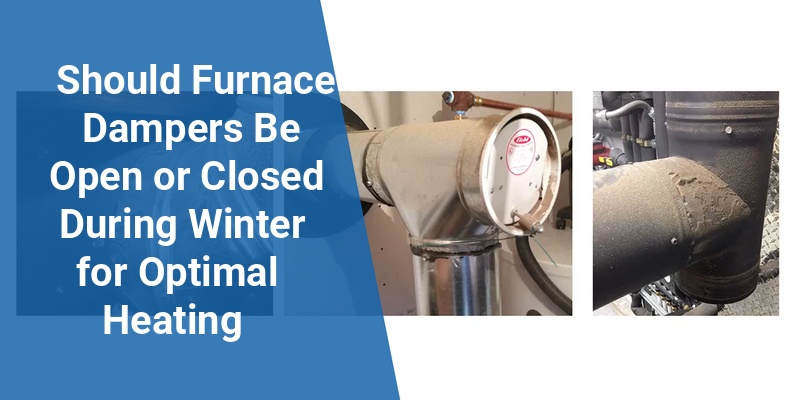When winter arrives, maintaining an efficient heating system is crucial for comfort and energy savings. One common question homeowners face is whether the furnace damper should be open or closed during the cold months. Furnace dampers regulate airflow and can directly impact heating performance and utility bills. Understanding how to properly use your furnace damper in winter can maximize heating efficiency and reduce energy costs.
| Damper Position | Effect on Heating | Energy Efficiency | Recommended Use |
|---|---|---|---|
| Open | Allows proper airflow, consistent heat distribution | Improves furnace efficiency and reduces strain | Keep open during winter for optimal heating |
| Closed | Restricts airflow, can cause uneven heating | Increases furnace wear, wastes energy | Generally avoid closing in winter |
What Is A Furnace Damper And How Does It Work?
A furnace damper is a movable plate installed within the ductwork system or the furnace itself. Its primary function is to regulate airflow through the ducts by opening, closing, or partially obstructing the passage. By adjusting the damper, homeowners can control the volume of heated air reaching different parts of the home. Dampers can be manual or automatic, often found near the furnace or within the main supply ducts.
Proper damper positioning plays a vital role in efficiency: If too closed, the furnace works harder to push warm air, reducing lifespan and increasing utility bills. If too open without need, it may allow heat loss in unused areas.
Why Keeping Furnace Dampers Open Is Best In Winter
During winter, the main goal is to distribute heat evenly and maintain indoor comfort. Opening furnace dampers fully allows warm air to flow freely throughout the home, optimizing heat delivery. Closed or partially closed dampers can create pressure imbalances, causing the furnace to cycle more frequently, increasing energy consumption and wear.
- Airflow Optimization: Open dampers ensure heated air reaches all rooms, preventing cold spots.
- Furnace Efficiency: Open airflow reduces strain on the blower and heat exchanger.
- Lower Energy Costs: Proper airflow means the furnace operates less frequently and more efficiently.
- Improved Indoor Air Quality: Circulation aids ventilation and reduces stale air buildup.
Factors That Affect Damper Positioning During Winter
Although the general recommendation is to keep furnace dampers open in winter, some situations may require slightly modifying damper positions.
Home Size And Layout
In larger homes with multiple zones, dampers may be used to direct heat to occupied areas only. Zone dampers work with thermostats to partially close ducts in unused zones, conserving energy. However, main furnace dampers should remain open to avoid airflow restrictions.
Type Of Heating System
Different heating systems such as forced air furnaces, heat pumps, or boilers have unique airflow characteristics. For forced air systems, keeping dampers open is critical, while hydronic systems that use radiators do not employ dampers in the same way.
Call 888-906-9139 for Free Local HVAC Quotes – No Obligation, Just Savings!
Ductwork Condition
Leaky or poorly insulated ducts may affect how damper adjustments impact heat distribution. Homeowners should regularly inspect and seal ducts to ensure maximum efficiency.
Common Misconceptions About Closing Furnace Dampers
Many homeowners believe closing furnace dampers in unused rooms saves energy by preventing heat from entering those spaces. This approach can backfire by disrupting airflow and increasing furnace workload.
- Increased Pressure: Closed dampers cause higher static pressure, leading to inefficient furnace operation.
- Uneven Heating: Some rooms become too warm, others too cold.
- Potential Damage: Excessive pressure can damage the furnace blower or ductwork over time.
Experts agree it is usually better to adjust your thermostat or use zoning systems rather than closing furnace dampers manually.
How To Properly Manage Furnace Dampers In Winter
To ensure optimal furnace operation and comfortable heating during the winter:
- Leave main furnace dampers fully open. This maximizes airflow and system efficiency.
- Use zone control systems if available. Programmable thermostats linked to zone dampers allow selective heating without restricting airflow at the main furnace.
- Inspect and maintain your ducts and dampers. Ensure all components are free from obstructions, clean, and functioning properly.
- Seal and insulate ductwork. Reduce heat loss and improve overall system performance.
- Consult HVAC professionals for system optimization. They can recommend appropriate damper adjustments based on your specific system and home layout.
Energy Savings Tips For Winter Heating
Beyond proper damper management, several strategies improve your heating system’s efficiency in cold months:
- Set programmable thermostats. Lower temperatures during night or absence to save energy.
- Regular furnace maintenance. Annual servicing ensures peak performance.
- Close curtains and use draft stoppers. Reduce heat loss through windows and doors.
- Upgrade insulation. Proper insulation reduces heating load and system strain.
- Consider a home energy audit. Identify areas of heat loss and inefficiency.
